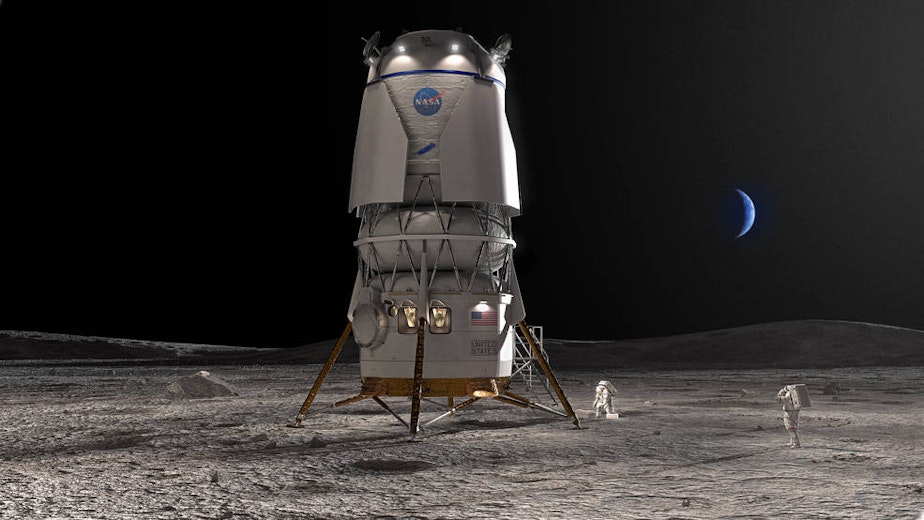NASA contract has Kent's Blue Origin feeling over the moon, and on it

Good news arrived for Kent-based Blue Origin Friday morning, but it may not have the aerospace company feeling over the moon — instead, it's heading straight for the lunar surface.
Blue Origin announced Friday that NASA has awarded it a $3.4 billion contract for "NextSTEP-2 Appendix P Sustaining Lunar Development." In human speak, that means the company is on a national team to develop a vehicle to take people between Earth and the moon, as well as a lander that can transport people to the surface.
Other members of this lunar lander team include Boeing, Astrobotic, Draper, Honeybee Robotics, and Lockheed Martin.
"Today we are excited to announce Blue Origin will build a human landing system as NASA’s second provider to deliver Artemis astronauts to the lunar surface,” NASA Administrator Bill Nelson said in a statement. “We are in a golden age of human spaceflight, which is made possible by NASA’s commercial and international partnerships. Together, we are making an investment in the infrastructure that will pave the way to land the first astronauts on Mars.”
While high fives are likely going around Blue Origin's Kent offices, the celebration is more regional. According to Sen. Maria Cantwell's office, through Blue Origin's contract, nine Western Washington companies will be suppliers for upcoming moon missions. They include:
- Baker Manufacturing Inc, Tacoma
- Electroimpact Inc, Mukilteo
- Janicki Industries Inc, Sedro Woolley
- Machine & Fabrication Ind LLC, Kent
- Machine Repair & Design Inc, Sumner
- Machinists Inc, Seattle
- McNeeley Mfg, Auburn
- Motion Industries, Tukwila, WA
- Specialty Metals Corporation, Kent
Also, a total of 42 companies across Washington are involved with NASA's current effort to return to the moon, and beyond.
That effort is called "Artemis." It is viewed as the first step toward eventual missions to Mars. In its own announcement, NASA notes that Blue Origin has been instructed to design a human landing system that can be reused. The vehicles should be able to dock with the Gateway (a lunar-orbiting station). From there, astronauts will be able to transfer to the surface. A uncrewed demo mission is slated for 2029.
Sponsored
Blue Origin will be specifically tasked with developing systems around LOX-LH2, which is used to power the vehicles. The propellant has not previously been used in space missions because of a unique problem — it tends to boil off quite easily. So Blue Origin plans to build solar-powered cryocoolers that can keep the fuel cold enough for storage. Blue Origin adds that this sort of technology is going to be important for future missions in space. Stable, storable LOX-LH2 could be used on eventual nuclear-powered spaceships. It can also be derived from ice, should it be discovered on the moon.
The announcement Friday comes after years of legal drama over NASA moon-mission contracts. The agency previously gave a contract to SpaceX to develop a moon lander for its Artemis III and Artemix IV missions. Blue Origin sued over that decision, arguing that it should have received greater consideration. It lost in court. With this latest contract, Blue Origin will develop a craft for the Artemis V mission.
RELATED: Jeff Bezos and three crewmates travel to space and back in under 15 minutes
NASA says that having multiple contracts for moon missions will "increase competition" and "reduce costs to taxpayers" while also investing in the "lunar economy."
According to NASA:
Sponsored
"For the Artemis V mission, NASA’s SLS (Space Launch System) rocket will launch four astronauts to lunar orbit aboard the Orion spacecraft. Once Orion docks with Gateway, two astronauts will transfer to Blue Origin’s human landing system for about a weeklong trip to the Moon’s South Pole region where they will conduct science and exploration activities. Artemis V is at the intersection of demonstrating NASA’s initial lunar exploration capabilities and establishing the foundational systems to support recurring complex missions in lunar orbit and on the surface as part of the agency’s Moon to Mars exploration approach."
RELATED: Why companies can't stop top execs from blasting off to space

